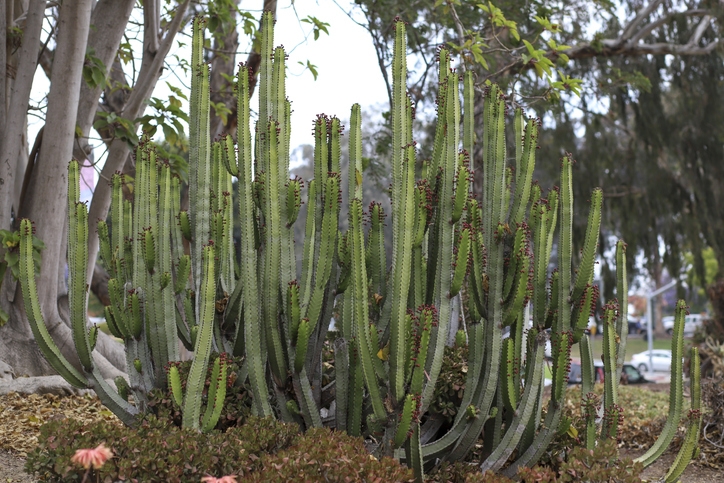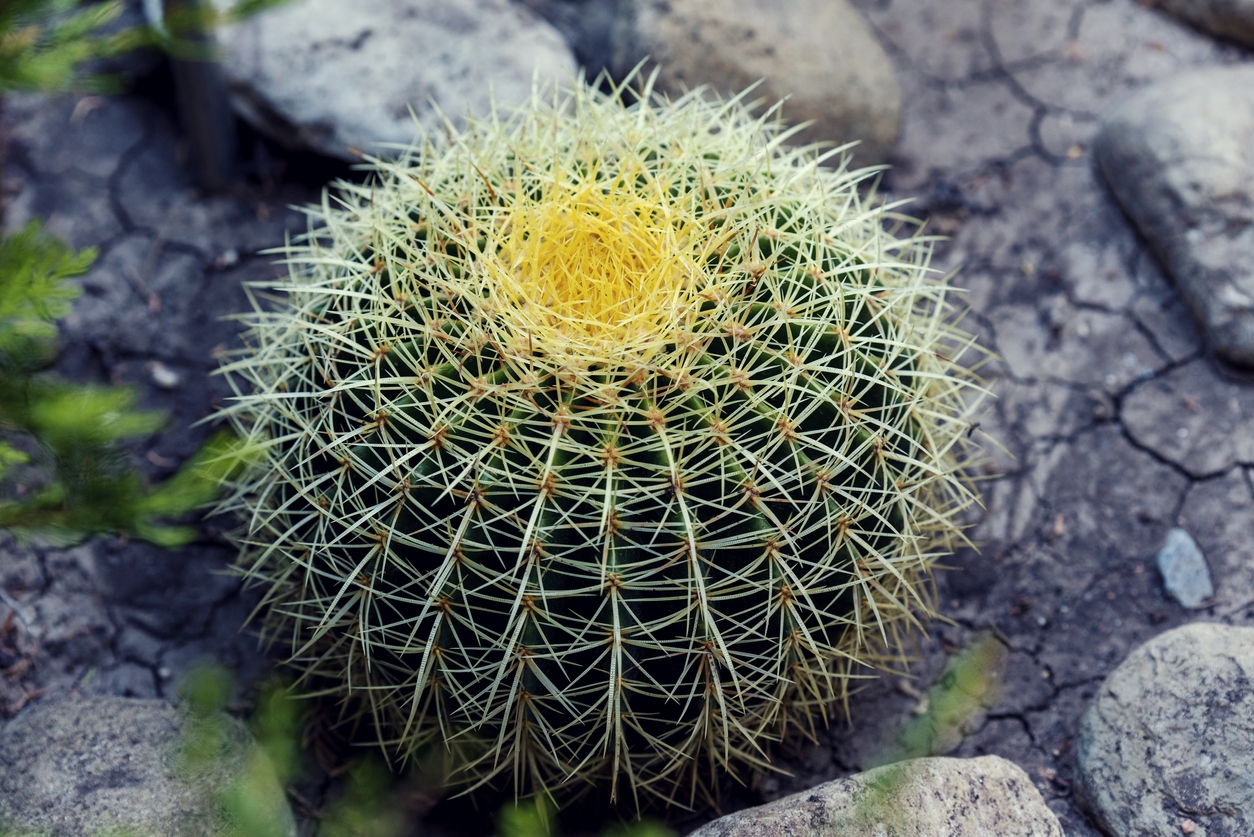If you dream of living in the Mojave Desert or already live under the New Mexican sky, the Land Of Enchantment, then you need to dress up your yard. We’re here to give you quick tips and walkthroughs to help you achieve just that.
If you’re looking for eye-catching fire pit ideas, read this article. Outdoor napping in a desert garden might be your desire, and if so then daybeds for the outdoors is the path for you. If you want pathway lights, then check this out.
What Is A Desert Landscape?

A desert landscape is natural or man-made. There aren’t many native plants or other plants in desert areas as there is very little rainfall. Whether it’s the Chihuahua Desert or Sahara, a few things remain the same – desert areas are a separate world where cactus, stones and rugged plant life live in harmony underneath a burning sun.
Let’s look at some great DIY desert landscaping ideas.
How To Get A Desert Landscape

There are plenty of different types of landscapes that are dry and desert-like. However, in the US, there’s one type of yard you’ll see appear more than others.
Desert Landscape Ideas
Here is a step-by-step guide how to achieve a better desert landscape. The best thing about it is how it doesn’t matter where you live.
Remove Non-Desert Plants
The first thing you will need to do is clear your existing landscape. Remove any lush, green plants that don’t grow in the desert. This includes grass.
A front yard lawn will not help your desert landscaping design. Removing green vegetation before transforming your front yard.
Note: Your yard is your space, and it should make you happy. If your shrubs make you smile, then desert landscaping ideas are on the right track.
Create A Pathway
To get a feel of your desert landscaping ideas, create a path in the dirt. Start at your front porch entrance and end at your sidewalk. The path should be a few feet wide and a few inches deep.
Right now, you should only have a ditch. Creating odd shapes in your lawn will add personality and curb appeal. You may want to curve it a few times from the middle but not drastic or it might be too hard to walk over.
For inclined yards, you can dig uphill and create stairs. They can be made with pavers or a set of outdoor stairs. In this case, keep the ground pathway straight as most staircases don’t swerve.
Weed Barrier
Place a weed barrier on your front yard. This will prevent unwanted similar plants or grass from growing. You can make holes in the ground where you want the grass to grow and cut out the area. Leave the barrier uncovered. It’s all about personal choice when it comes to your garden, and once you begin you won’t run out of ideas.
Mid-Size Boulders

Pick more than one space and dig holes for your stones. The hole should be about one-third to one-half the size of the boulders you choose. The boulders should be placed in the holes and left to cover later.
For odd shape boulders in your front yard, you can leave the boulders on the gravel. It will look like art and less natural. Both ideas are fine, and many desert landscapes use one or the other. It’s better if you place boulders in random spots rather than position them in straight lines.
Add Chosen Plants
Create more holes in the barrier for green plants and shrubs in your front yard. We will talk more about other ideas and desert plants later, but if there are plants and pots you have your heart set on, make sure they are placed in the right space.
Cover With Gravel
Cover your yard space with gravel, sand, or dirt. Whatever you choose, go with a desert dust color. Dark browns and green won’t work. Beige and tan are better colors. Sand colors work best in a desert landscape.
Natural Mounds
Put extra dirt and gravel in certain spots, preferably near the rocks. Cover sides of the rocks to make it look like they’ve been sitting there for years. Then, create other mounds around the area as not all deserts are perfectly flat.
Fill And Pave Walkway
Feel the walkway with pavers of your choice. You can use concrete pavers or even natural stones. You may need to add a base for them made of finer gravel. Sand will sink and make your walkway uneven.
Cinder Blocks
Cinder blocks offer opportunities to create design patterns and surfaces for smaller pots plant life and other outdoor decor. They’re also great additions to a rock garden.
Desert Landscape Plants – What Makes A Desert Plant Special?

Desert plants are unique. The great thing about them is their ability to survive. The following plants are found in deserts landscaping settings and are easy to grow in your front yard with excess water.
Native Plants
Native plants allow you to create a natural landscape design in your front yard. Potted plants are fine, but you want at least one focal point for visual interest. A landscape design that consists of a large area will receive intense sunlight, so your plants need to be strong enough to handle hot climates.
Thread Grass
Also called Nassella, desert thread grass is a substitute for real grass. It is dry and wiry but can cover a lot of ground. It can grow upwards of two feet or higher might not be right for your front yard, but would look better in your back yard.
Ghost Plant
The ghost plant is a succulent with a unique shape. They require very little maintenance and will work both indoors, or outdoors. With yard design they are good for walkways or near windows where you want the eye drawn. If you want to defy gravity, let the ghost plant work its magic.
Elephant Tree
The elephant tree gets its name from the fact that it can store water in its trunk just like an elephant. If you want large desert trees instead of shrubs, this might be the best option. The trees can grow up to ten feet, and are ideal for small to medium-sized yards.
Prickly Pear
Not only are prickly pears a great-looking desert plant but they’re also edible. They taste like berries. During certain periods, the plant is green, but will later sprout redbuds.
Organ Pipe Cactus
The organ pipe cactus is popular. It grows in a way that pleases those looking for symmetry and eccentricity.
Desert Marigold

Bright colors are sparse in the desert landscape but make great accent pieces. When you find desert flowers that grow bright and plentiful, you’ve found a few gems.
Barrel Cactus
This cacti comes in two forms: global or sphere. Golden spines line the ribs. The top is features bright yellow flowers that grow from a wool patch. The yellow globes add beauty and can fill your front yard with that extra zing that any desert landscape deserves.
Desert Palm
The desert palm is a popular indoor plant that gives you a taste of the desert tropics. It looks like a regular palm tree but doesn’t require the same moisture to survive. It’s a must if you want tropical flair in your yard.
Winecup
The winecup flower offer a dark color uncommon in desert landscapes. The delicate plants produce purple flowers that beauty to a bland front yard.
Thyme
Thyme is a herbs that grows in the desert. If you want a green herb garden with vegetation, thyme would be nice addition. You can make thyme the focal point of your front yard garden bed.
Red Yucca
Yucca plants thrive in the desert and add texture and beauty to desert gardens. Red yucca is softer than other yuccas and has red sprigs. It will add color to your yard throughout the year and provide nutrients to your other vegetation.
Agave
Agave plants grow in super dry regions. Some are small while others are large. Foliage and symmetry highlight these xeric plants in your garden.
Added Touches

It’s time to add the finishing touches that make your desert landscape yours. They are your personal choice and will create more inspiration for your desert landscaping ideas.
Find Your Culture
Since deserts are found throughout the world, so you’ll find cultural inspiration in whatever front yard design you choose.
Animal Skulls
If you want a US or China desert landscape, then animal skulls are a great addition. They don’t need to be real, but you can buy fake animal skulls online.
Paint Your House
If you have a dim-colored yard, then painting your house a bright color will eye-catching. The New Mexican culture offers inspiration for brightly colored houses. Dark blues, reds, and green colors are common.
Bright Tiles
Another way to add color is to add tiles. It can be a walkway, a bench, or even accent pieces around the door. This is the best way to add great color accents like green to your yard while maintaining a desert look.
Steel Art
If you want art that is safe to add to a desert landscape, consider steel. You can get animal cutouts or even those from local tales and legends. Use one custom-made for your yard by contacting a welder.
Pergolas

Since desert landscapes don’t offer a lot of shade, adding your own shade can be a great relief from the sun. Pergolas are mroe common in desert landscapes than gazebos or pavillions, so they will look natural.
Add A Fountain
Adding a fountain is a good way to provide moisture to desert areas, and will help you irrigate or mulch your greenery. Make sure the fountain matches your landscaping.
Desert Landscaping ideas Frequently Asked Questions
What Are Some Benefits of Fake Grass?
Fake grass does not need mulch or watered and is eco-friendly. As a natural grass alternative, it’s made from recycled materials. One downside is that fake grass can get hot when the sun is out in full force, so running barefoot on your fake lawn would be like walking on hot coals.
What Type Of Soil Should I Use For Desert Plants
Desert soils have the highest alkaline levels you’ll find anywhere. Many plants require fertilization to grow in a desert landscape environment. With desert landscaping, you have opportunities to generate healthier plants and cactus than you would without the special soil or more water.
What Is Xeriscaping?
Xeriscaping is the practice of desert landscaping with minimal water use. Homes and businesses in desert climates use rocks and cactus for their garden xeri projects. The art of creating landscaping design is a skill that that can turn a space into a landscaping marvel.
What Is The Paint For Outdoor Rocks?
Acrylic water-based paint will work best for your fake desert rocks. Painted rocks look cool around trees or in a garden. You could also surround your cacti with or garden bed with acrylic painted rocks.
How Do I Keep Scorpions Out Of My Fake Desert?
Scorpions eat crickets and other insects. If you want to protect your fake desert environment from scorpions, the first thing you should do is remove their food source. Extra large rocks and palm trees attract scorpions as they provide refuge.
Desert Landscaping Ideas Conclusion
There aren’t a fixed set of rules or ideas for desert landscape design. You can draw inspiration from other landscapes, and infuse those designs into your personal desert hideaway. Remember, you don’t have to gravity, but just be yourself and let your desert landscaping skills flourish.
The post Creating The Perfect Desert Landscape appeared first on Home Decorating Trends - Homedit.









0 Commentaires